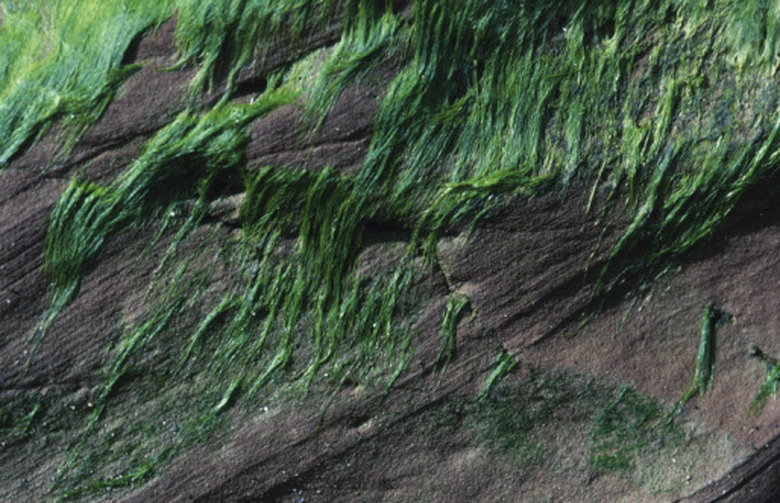The Morphology Of Algae
In the not too distant future, advances in DNA identification could potentially change the way that ambiguous organisms like algae are classified. In the meantime, phycologists will continue to rely on a naming and classification system of morphology introduced by Carl Linnaeus in the 1700s. Like other members of the kingdom Protista, algae are eukaryotic organisms with a nuclear envelope, cell walls and organelles.
Main Characteristics of Algae
Main Characteristics of Algae
Algae are protists, an incredibly large group of organisms with markedly different features. The form and structure of algae sets them apart from plants. Although algae and plants both contain chlorophyll and photosynthesize, algae don't have an actual root system, stem or leaves. Algae cells are typically simpler than plant cells and have fewer organelles in their cell cytoplasm.
There are few places on Earth where algae cannot be found. Algae thrive in places where few plants would dare to go. Habitats include everything from the deepest ocean to snowy mountain caps to hot springs and salt marshes.
Most species of algae are single-celled micro-organisms living in aquatic environments. Algae are primary producers on the bottom of the food chain that feed consumers. Algae are often distinguishable by their color.
Golden Brown Algae (Chrysophytes)
Golden Brown Algae (Chrysophytes)
Golden algae (Chrysophytes) are common microscopic organisms that provide food for zooplankton in fresh water. Most are functionally photosynthetic, but under the right conditions, golden algae feed on bacteria. Structurally, golden algae are mostly unicellular and free-swimming, but some species exist as colonial algae and stringy filaments. Chrysophytes like diatoms can be seen in fossil records dating back to the Cretaceous age.
Common Green Algae
Common Green Algae
More than 7,000 species of green algae have been identified, according to the UC Museum of Paleontology. Freshwater green algae like Spirogyra in the Charophyta phylum are more closely related to plants than marine green algae (Chlorophyta). Green algae resembles a plant because it contains chlorophyll and uses sun energy to drive photosynthesis. The structure of green algae can be single- or multiple-celled.
Red Algae (Rhodophyta)
Red Algae (Rhodophyta)
The typical red algae (Rhodophyta) is a rose-colored multicellular organism found in marine environments around the world. Accessory pigments called phycobiliproteins are responsible for the distinctive red coloring. Like green algae, red algae traces back to ancestral cyanobacteria. Certain types of red algae are edible and used to make products like agar and food additives.
Brown Algae (Phaeophyta)
Brown Algae (Phaeophyta)
Brown algae (Phaeophyta) are multicellular organisms that derive their color from the brownish pigment fucoxanthin in chloroplasts along with chlorophyll. According to the Seaweeds of Alaska website for phycologists, brown algae are bigger and more morphologically complex than any other type of marine algae. Brown algae make their food through photosynthesis and store polymers of glucose in a vacuole within the cell cytoplasm. Familiar examples of brown algae are seaweed and kelp.
Fire Algae (Pyrrophyta)
Fire Algae (Pyrrophyta)
Phytoplankton are microalgae divided into two subgroups: diatoms and dinoflagellates. Phytoplankton play an important role in the food chain and ecosystem by converting nitrates, sulfur and phosphates into carbon-based nutrients. Runoff from farm fields and other pollutants can result in phytoplankton overgrowth and the formation of highly toxic harmful algal blooms (HABs).
Deadly HABs, referred to as "red tides," form large, putrid-smelling masses over bodies of water. Bioluminescent types of dinoflagellates are called fire algae because they chemically emit light and glow like flames. At night the bioluminescent HAB appears on fire.
Yellowish Green Algae (Xanthophyta)
Yellowish Green Algae (Xanthophyta)
Xanthophyta are yellow-green algae that live in fresh water. They may be unicellular in morphology or colonial algae, bunched together. Color is derived from green, yellow and orange pigments involved in photosynthesis. Flagella make this type of algae motile in water.
References
- UC Museum of Paleontology: Introduction to the "Green Algae"
- UC Museum of Paleontology: Introduction to the Rhodophyta
- UC Museum of Paleontology: Introduction to the Chrysophyta
- Seaweeds of Alaska: Ochrophyta
- "Freshwater Dinoflagellates of North America"; Susan Carty
- NOAA: What Is a Red Tide?
- NOAA: What Are Phytoplankton?
Cite This Article
MLA
Dowd, Mary. "The Morphology Of Algae" sciencing.com, https://www.sciencing.com/morphology-algae-8493664/. 22 March 2019.
APA
Dowd, Mary. (2019, March 22). The Morphology Of Algae. sciencing.com. Retrieved from https://www.sciencing.com/morphology-algae-8493664/
Chicago
Dowd, Mary. The Morphology Of Algae last modified March 24, 2022. https://www.sciencing.com/morphology-algae-8493664/
